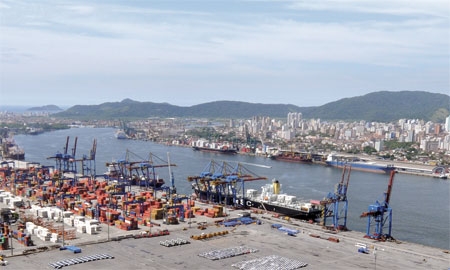In addition, hosting two of the world’s biggest sporting events in the next few years – the 2014 FIFA World Cup and the 2016 Olympics – has added further impetus to enhancing the republic’s ports, airports, urban roads and rail infrastructure. So, as part of its accelerated growth programs, PAC 1 and PAC 2, Brazil plans to invest US$562 billion on boosting its infrastructure by 2014, with 30% to 40% of the total expected to come from the private sector.
Some 90% of Brazil’s foreign trade is handled by its ports. In 2007, the creation of the Special Secretariat for Ports (SEP) stimulated a great national movement for government officials and businessmen to raise efficiency and capacity at the country’s maritime gateways. Various upgrade programs have already taken place and are ongoing, including dredging works to deepen the ports to accommodate bigger vessels, such as the super-post-Panamax container ships. The government has earmarked US$900 million for a national dredging program, and US$1 billion on improving port infrastructure and land access.
Brazil’s most important is the Port of Santos. It is located just 38 miles from São Paulo, the most industrialized region in the southern hemisphere and also the largest consumer and producer market in Latin America. The Port of Santos has experienced constant annual growth and this year anticipates breaking the 100 million tons mark, reaching 101 million tons of cargo handled by the end of 2011. Port authority CODESP, Companhia Docas do Estado de São Paulo, aims to increase the port’s throughput capacity over the next five years to 10 million TEUs (twenty-foot equivalent units).
“We have already started expanding and building new terminals large enough to manage that kind of volume, financed by the private sector. The project as a whole includes dredging the port, modernizing the eight miles of dock space, and expanding the port and its facilities to almost double its capacity,” says Jose Roberto Correia Serra, president of CODESP. “We have two ongoing projects. First, we are creating a dock for cruise ships with a passenger station in the part of the port that has cruise attractions. This project will be completed by the 2014 World Cup. Second, we are significantly revitalizing the historical area of the port, and making it into a large cruise ship terminal. This project will likely be completed shortly after the World Cup, and will make the Port of Santos one of the most modern cruise ship terminals in the world.”
The Port of Santos is the largest sugar and orange juice exporter in the world. The port complex also stands out in the shipment of coffee, soybeans and pellets, ethanol, vehicles and manufactured goods. It is responsible for over a quarter of Brazil’s trade balance.
Thanks to privatization, the bids for the terminals and their focused operations have given rise to growth throughout the entire port system. “Today virtually 100% of Brazilian port operations are in the hands of private companies,” says Antonio Carlos Duarte Sepulveda, president of Santos Brasil, which operates the Tecon of Santos container terminal. “Brazil has begun adopting rules of transparency and this has attracted private investment not only from Brazilian investors, but also American, British, and German investors.”
The company offers loading and unloading services, such as berth-related services; backyard-related services, including the warehousing of import and export containers and lots; and other services comprising handling and delivery of containers to dry ports, and handling of vehicles.
“We go beyond unloading the ship, stocking the cargo in the yard, and delivering it to the client. We try to make the clients loyal to the port terminal by offering a wide range of services. Today 60% of our revenue comes from port operations like loading and unloading ships, while 40% comes from logistics products,” says Mr. Sepulveda.Tecondi has operated container terminals and provided logistics solutions at the Port of Santos for more than 10 years.
“We have a very specific and strong focus on port operations and cargo storage, and we have a sister company that is also located on the dock and offers storage facilities and services,” says Luiz Araujo, commercial director of Tecondi. “The joint efforts of our companies offer a series of services for various world-renowned clients, among them DHL, who has been our customer for over nine years, Panalpina, and Schenker. Not to mention the shipowners themselves, who are also part of our clientele.”
Tecondi puts an emphasis on technology and all of its operations are computerized, playing a part in the drive to make Santos a “paper-free port”. Mr. Araujo says, “Tecondi has developed a management system for shipyards and terminals, and an efficient administrative system that coordinates the yards. This was done to increase productivity and minimize cost, as well as reduce unnecessary movement in the yards.”
The terminal is located right in the entrance of the port, a privileged spot, close to major highways and directly connected to railroads, allowing for fast and safe cargo handling.
Mr. Araujo says, “I would like to see Tecondi develop in terms of logistics, which can be somewhat complicated. Logistics involves road transport, which carries several financial implications that can be difficult. As a whole, the process is interesting, but also extremely challenging.

0 COMMENTS